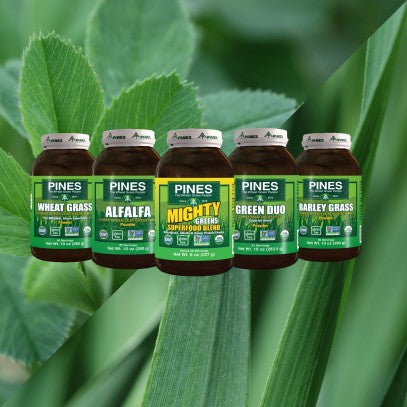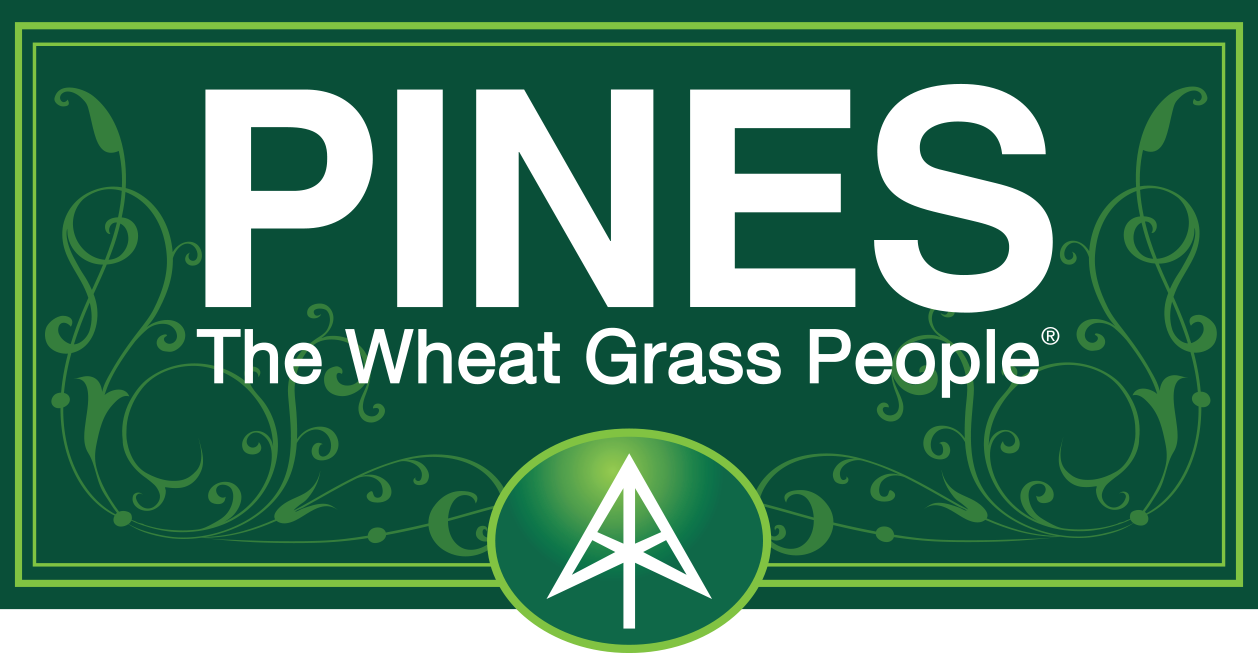
Pines' packaging manager, Jason, is putting a shelf of Pines Wheat Grass into the vacuum chamber. This reinforced heavy steel box is used to create a vacuum that removes the air from each bottle. We then replace the air with an oxygen-free atmosphere.
We go to this expensive and time-consuming effort because when Charles Schnabel first grew wheatgrass and other cereal grasses on our farm in 1932, he used this method before sending the powdered grasses to hospitals and doctors for the research discussed by Ann Wigmore and other authors.
Dr. Schnabel also had researched the difference between removing the oxygen from a bottle and using a normal atmosphere containing 20% oxygen. He discovered that over time, the oxygen-free bottles scored significantly higher on many key components such as chlorophyll and betacarotene.
For the next 50 years, green food powders and tablets were always packaged amber glass bottles with the oxygen removed. In the 1980s several, companies, inspired by Pines' success, decided to compete by not using oxygen-free bottles because they cost more.
Not only did they save money by not removing the oxygen, but they also used cheap plastic tubs instead of glass bottles. Plastic is the worst possible packaging for a green superfood. Without a tight seal and without an oxygen-free environment, greens sold in a plastic tub are usually not very green. Some are even more yellow or brown than green.
The poor color of greens in plastic tubs proves again Dr. Schnabel's research from nearly 100 years ago. Without removing the oxygen, green food powders are not a good value. That's because products they can sit on shelves and warehouses for months or even years and slowly lose the nutrients that people need for good health.
And that's not even mentioning how horrible plastic is for our planet. Shards from those plastic tubs kill wildlife. Plastic containers pollute oceans and groundwater below landfills. The average American now consumes 50,000 microscopic plastic particles each year.
Glass is non-toxic. If it isn't recycled, it can be ground back into the sand that was used to make it. Plastic can only be recycled once. After that, the plastic slowly deteriorates and pollutes the planet for hundreds of years.
For the sake of everyone's health and safety and for the sake of the planet, we wish every green food producer would go back to the oxygen-free glass bottles that Dr. Schnabel and Pines have always used.
Recently, we found a bottle that was 22 years old. After opening it, we discovered the color of the Pines Wheat Grass tablets were just as green as when they were put in the bottle 22 years before.
Removing Oxygen from Containers Extends Freshness
We need oxygen. It is essential for life. Our bodies use it to convert food into energy. Oxygen is essential for life. Even so, when in contact with wheatgrass powder or other highly-pigmented superfoods, nutrients slowly devitalize through oxidation. That's why it is important to remove the oxygen.The Father of Wheatgrass Always Removed Oxygen
By volume, air contains 20% oxygen. That's why highly pigmented superfoods like wheatgrass powder, packaged in containers filled with air, slowly oxidize. That means it loses nutrition while in transit, while it sits in a warehouse and while it sits on a store’s shelf.Over the course of months, oxidation devitalizes and deteriorates some of the most valuable nutrients in green food. The effect of oxidation on wheatgrass and other highly pigmented superfoods was a great concern for Dr. Charles Schnabel. That’s why in 1932, Dr. Schnabel packaged his wheatgrass powder in amber glass bottles with specially-designed metal caps.
That packaging allowed Dr. Schnabel to remove the air from each bottle and replace the air with nitrogen. The result was a body of research that inspired Ann Wigmore and other authors.
Because of his work, Steve Meyerowitz called Schnabel called “the father of wheatgrass” in his dedication to "Wheatgrass: Nature’s Finest Medicine."
How Do We Do It?
 First, we put the filled bottles with the special metal caps into a vacuum chamber with the caps not quite screwed down tightly.
First, we put the filled bottles with the special metal caps into a vacuum chamber with the caps not quite screwed down tightly.  After we fill the vacuum chamber with bottles, we seal it. Then, a vacuum pump removes nearly all the air from the chamber, including the air inside each bottle. Normally, air contains 78% nitrogen and 21% oxygen. Instead, we replace it with >98% nitrogen and <2% oxygen. That means the bottles are essentially "oxygen-free."
After we fill the vacuum chamber with bottles, we seal it. Then, a vacuum pump removes nearly all the air from the chamber, including the air inside each bottle. Normally, air contains 78% nitrogen and 21% oxygen. Instead, we replace it with >98% nitrogen and <2% oxygen. That means the bottles are essentially "oxygen-free."  After that, we remove the bottles from the chamber with the nitrogen atmosphere in the bottles. The pressure in the bottles is the same as the surrounding air. As a result, the nitrogen stays in the bottle long enough to go through a cap tightening machine to tightly screw down the metal caps. The special seal inside each cap prevents the outside air and humidity from entering the bottle.
After that, we remove the bottles from the chamber with the nitrogen atmosphere in the bottles. The pressure in the bottles is the same as the surrounding air. As a result, the nitrogen stays in the bottle long enough to go through a cap tightening machine to tightly screw down the metal caps. The special seal inside each cap prevents the outside air and humidity from entering the bottle.After you bring the bottle home and open it, the tight-fitting seal helps to keep the product fresh between uses. Thus, when you open any bottle from Pines, the contents remain as fresh as the day as when packaged. That's because of the oxygen-free protection, the glass bottles, and the special metal caps.
Pines' Green Superfoods are Organic and Non GMO
All Pines' products are Certified Organic, Non-GMO Project Verified, gluten free and Kosher. They are available at leading natural food stores or direct through our shopping cart.




Comments (0)
There are no comments for this article. Be the first one to leave a message!